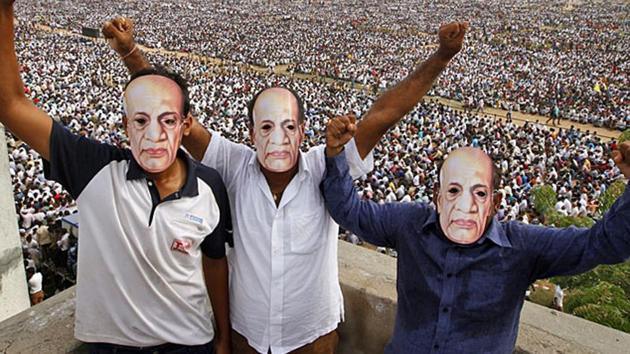Gujarat elections: How caste has emerged as key factor in the high-stakes battle
Both the parties are locked in a fight to attract influential castes, many of have been staunch supporters of the BJP but have become disenchanted with the party’s 22-year-long rule.
The BJP and the Congress might be talking about jobs and development at their campaign rallies but caste has emerged as a significant factor in Gujarat after years and might decide the fate of the assembly election in December.

Both parties have been locked in a months-long fight to attract influential castes, many of have been staunch supporters of the BJP but have become disenchanted with the party’s 22-year-long rule in Prime Minister Narendra Modi’s home state. In focus have been three young men – Patidar leader Hardik Patel, OBC leader Alpesh Thakor and Dalit leader Jignesh Mewani.
At the core of the renewed caste politics are the Patidars, a traditionally BJP-supporting community that comprises 12% of the state’s 60 million population and hold influence in at least 60 of the 182 seats.
The Patidars, led by the firebrand Hardik Patel, hit the streets in July 2015, demanding OBC status that would result in quotas in jobs and education. This community of farmers, diamond barons and some of the biggest industrialists in Gujarat – who saw a fall in fortune in recent decades as agriculture declined -- suddenly moved away from the BJP, especially the younger generation.
The impact was immediate. In the local body elections in December that year, the BJP suffered heavy losses across the countryside with its kitty of panchayats more than halved. The party won just 73 panchayats compared to the Congress’ 132, boosting the opposition party that had lost virtually every election in the state for a decade by then.
The loss, experts say, made the BJP realise that caste dynamics in the state were shifting and the Patidars – who shifted to the saffron party in the 80s – were now a fractured votebase.
In 1980, the Congress stitched together a rainbow coalition– called KHAM for Kshatriya, Harijan (Dalits), Adivasi (Tribals) and Muslims – that brought together nearly 40% of the state’s population and brought former chief minister Madhavsinh Solanki to power with a record 141 seats in a 182-member assembly.
“But the move was instrumental in pushing Patidars, who were then emerging as the economical backbone of the state, towards the BJP,” says political analyst Hari Desai. “Since then, this is the first election when caste equations are clearly at the forefront.”
In 2002, the BJP won its biggest-ever victory under then chief minister Narendra Modi. The election was held in the aftermath of the 2002 Godhra train burning and subsequent riots, where more than 1,000 people died.
``If the communal divide dominated the elections in 2002 held in backdrop of communal riots, Narendra Modi made efforts to change the narrative to development issues in subsequent elections. But this time due to agitation by various communities, the caste equations are back as the central idea,” said analyst Achyut Yagnik.
This time, the Patidar movement, counter-protests by a section of the OBCs and agitations by Dalits against atrocities have brought caste to the fore.
Both parties know this. The Congress is trying to revive KHAM while the BJP is trying to placate the Patidars.
On October 23, when Congress vice president Rahul Gandhi started his speech in Gandhinagar with slogans of Jai Mataji (Kshatriyas), Jai Sardar (Patidars) and Jai Bhim (Dalits), it was seen as a bid to invoke KHAM, but with an addition of P (Patidar).
The same stage was also a platform for the formal induction of Alpesh Thakor into Congress.
But his addition might not go down well with OBC status-seeking Patidar because Thakor emerged on Gujarat’s political scene floating on his strong opposition to granting Patidars an OBC tag.
Gandhi has also visited several temples in his visits to Gujarat, including the Shree Khodaldham (Patidar’s deity temple) and Phagvel (an important Kshatriya pilgrimage).
The BJP has withdrawn nearly 400 police cases against Patidar youth registered after violent protests by the community to push for their quota demand.
After the BJP’s move to introduce 10% reservation for economically backward classes from all non-reserved communities was struck down by the court, the state government this month formed a commission as well as a corporation to look after various needs of the non-reserved castes.
But the party still hasn’t been able to devise a strategy for the state’s Dalits, who are angry after a surge in atrocities, especially the flogging of scheduled caste men by alleged cow vigilantes in Una last year.
The Congress has gone all out to woo Jignesh Mevani with the party’s Gujarat in-charge Ashok Gehlot saying he had a good meeting with the young Dalit leader this week. But Mevani has kept his cards close to his chest.





